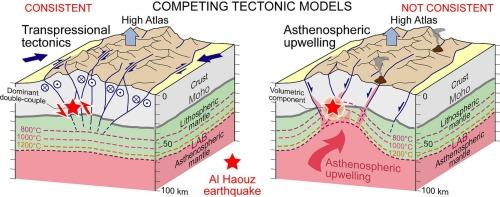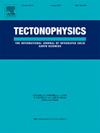Tectonics of the Mw 6.8 Al Haouz earthquake (Morocco) reveals minor role of asthenospheric upwelling
IF 2.7
3区 地球科学
Q2 GEOCHEMISTRY & GEOPHYSICS
引用次数: 0
Abstract
A reliable identification of the fault responsible for the magnitude 6.8 Al Haouz earthquake that struck Morocco on 8 September 2023 has so far been hampered by a lack of accurate tectonic analyses. Here we provide the first updated tectonic framework of the earthquake epicentral area based on original field data. We cast our results into the context of available geomorphological, thermochronological and geophysical constraints, and discuss the earthquake characteristics within the framework of competing tectonic models either based on asthenospheric upwelling or transpressional tectonics. We found that the Al Haouz earthquake was likely generated by rupture along a north-dipping high-angle fault, linking former fault planes belonging to an orogen-scale WSW-ESE transpressional shear zone. The geological evolution and seismotectonic structure of the region are largely governed by the oblique convergence of tectonic plates. The impact of asthenospheric upwelling, if any, remains limited and may only influence the geomorphological evolution of the Western High Atlas, but cannot explain the seismotectonic and geological features observed today at the surface, which are instead effects of transpressional tectonics.

6.8 级 Al Haouz 地震(摩洛哥)的构造揭示了星体层上升流的次要作用
2023 年 9 月 8 日,摩洛哥发生了 6.8 级豪兹地震,迄今为止,由于缺乏准确的构造分析,无法可靠地确定造成此次地震的断层。在此,我们基于原始的实地数据,首次提供了地震震中地区的最新构造框架。我们将研究结果与现有的地貌学、热时学和地球物理学制约因素相结合,并在基于星体层上升流或转位构造的相互竞争的构造模型框架内讨论了地震特征。我们发现,Al Haouz 地震很可能是沿着北倾高角断层发生的断裂,该断层将属于造山带尺度的 WSW-ESE 换压剪切带的前断层面连接起来。该地区的地质演变和地震构造结构在很大程度上受构造板块斜向聚合的影响。星体层上升流的影响(如果有的话)仍然有限,可能只会影响西高阿特拉斯的地貌演变,但无法解释今天在地表观察到的地震构造和地质特征,这些特征是换位构造的影响。
本文章由计算机程序翻译,如有差异,请以英文原文为准。
求助全文
约1分钟内获得全文
求助全文
来源期刊

Tectonophysics
地学-地球化学与地球物理
CiteScore
4.90
自引率
6.90%
发文量
300
审稿时长
6 months
期刊介绍:
The prime focus of Tectonophysics will be high-impact original research and reviews in the fields of kinematics, structure, composition, and dynamics of the solid arth at all scales. Tectonophysics particularly encourages submission of papers based on the integration of a multitude of geophysical, geological, geochemical, geodynamic, and geotectonic methods
 求助内容:
求助内容: 应助结果提醒方式:
应助结果提醒方式:


